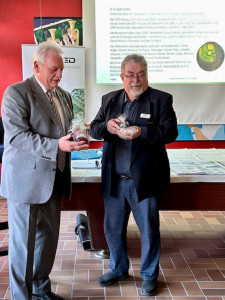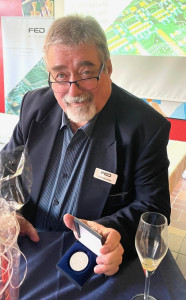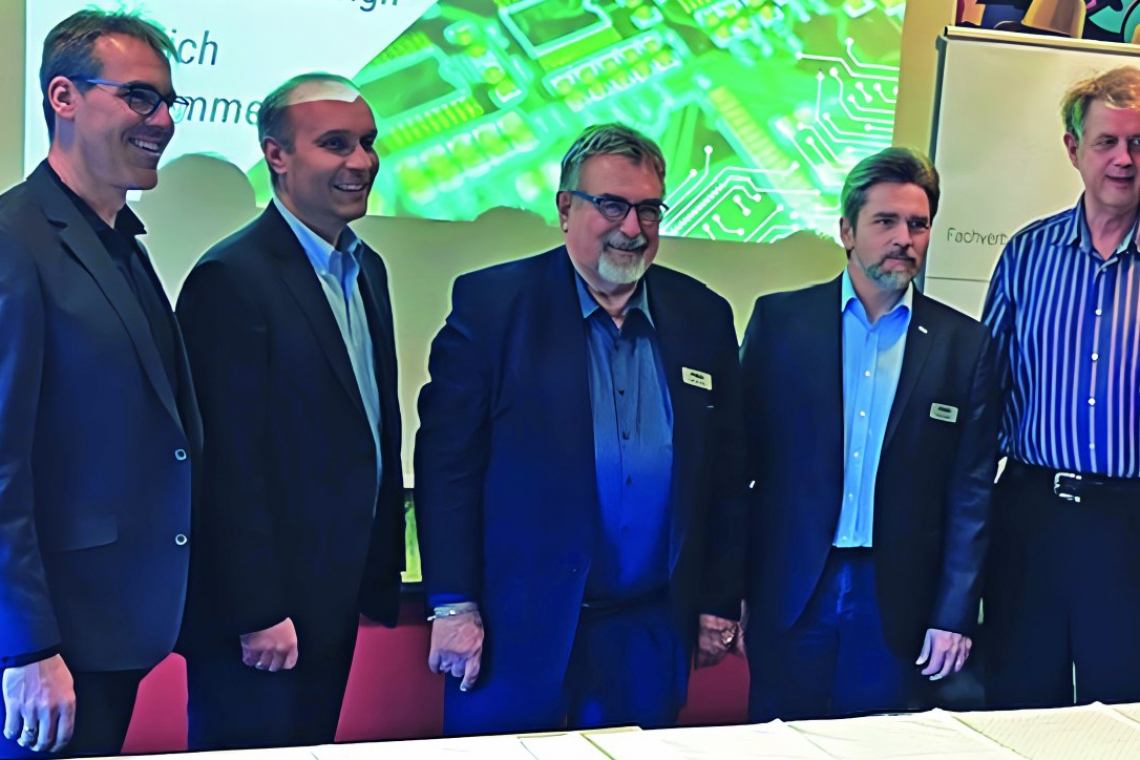A reception was held at the Bavarian School of Administration in Neustadt/Aisch to mark the anniversary. This is where the first and since then regular FED designer courses took place. This is thanks to FED honorary member Gerhard Gröner, who was awarded the badge of honor by the town of Neustadt/Aisch.
The training and further education of PCB designers is one of the main concerns of the FED (Fachverband Elektronikdesign und -fertigung e. V.). The first FED conference in 1992 already discussed how this could be realized. At that time, there were no suitable offers. Gerhard Gröner took up the cause and developed a concept. In March 1999, the first course started at the Bavarian School of Administration (BVS). Since then, the range of training and further education courses offered by the FED has been systematically expanded, culminating in the Certified Electronics Designer (ZED) in several stages. This is because the rapidly advancing development in electronics technology and in the design of electronic assemblies requires adequately qualified circuit board and assembly designers.
In his welcoming address, BVS Managing Director Thorsten Göbel emphasized that the BVS would like to see the FED continue to offer courses in Neustadt/Aisch in the future. This was echoed by Mayor Klaus Meier, who praised the positive impact this would have on his town's economy. FED board member Michael Schleicher noted that the BVS in Neustadt/Aisch is a good place for a success story. At the reception, Gerhard Gröner reviewed how everything has developed. This is reproduced below.
The path from the first course to the ZED and today's offer
 Mayor Klaus Meier (left) presented Gerhard Gröner (right) with the Neustadt/Aisch badge of honor for his servicesAfterretiring from his job, Gerhard Gröner had the idea of creating a training opportunity for PCB designers based on his many years of professional experience. At the time, there were virtually no training opportunities for this interdisciplinary technology. Together with the then relatively new trade association FED, he thought about how a further training concept for PCB designers could be developed. The advisory board approved the concept and instructed him to implement it.
Mayor Klaus Meier (left) presented Gerhard Gröner (right) with the Neustadt/Aisch badge of honor for his servicesAfterretiring from his job, Gerhard Gröner had the idea of creating a training opportunity for PCB designers based on his many years of professional experience. At the time, there were virtually no training opportunities for this interdisciplinary technology. Together with the then relatively new trade association FED, he thought about how a further training concept for PCB designers could be developed. The advisory board approved the concept and instructed him to implement it.
At that time, the FED only had a small office in Berlin, so Gerhard Gröner looked for a training location. He found one in 1998 in his home town of Neustadt/Aisch. As the BVS was planning to close its branch in Neustadt/Aisch, an agreement was reached to use its premises for the FED designer courses.
In March 1999, the first five-day basic course was held at the BVS branch in Neustadt/Aisch, later known as the LBD I circuit board designer course. The course is now part of the FED's step-by-step course system (ZED program) as ZED II. Twelve participants took part in the first course.
The first course was structured according to the following principles: PCB and assembly design (LP design) is carried out taking into account electrical and physical requirements according to the specifications of circuit development and taking into account the requirements for subsequent PCB manufacture and assembly production. There was no examination at that time. The course was expressly welcomed by the participants and the FED was asked to continue.
Further development was characterized by cross-section technology and the training content had to be found for this technology, which was relatively unknown outside the industry. This is because the realization of the function of an electronic assembly is not done with circuit development and component selection. The circuit must be physically constructed with printed circuit boards. The choice of the appropriate assembly and connection technology (AVT) and the associated components is of great importance for manufacturability, manufacturing costs, functionality, quality and reliability/operational safety.
The requirements have grown increasingly with the further development of the courses. Topics such as component libraries, SMT, rigid-flex printed circuit boards, impedance control, etc. required the addition of two three-day courses from 2000 onwards, then called AK I and II.
In addition to the specially created FED regulations, the guidelines of the American association IPC such as IPC 2221 etc. formed the basis for the courses. The IPC director at the time, Dieter Bergman, therefore also introduced us to the examination for the international CID (Certifed Interconnect Designer) certificate. In April 2001, he himself took the first exam in Neustadt.
In August 2002, the American examination papers for the CID+ (Advanced Certified Interconnect Designer) were translated and the questions for the FED Designer were prepared at the Alleehotel in Neustadt. This resulted in a further advanced course, AK III, the first of which was held on the fringes of the 10th FED conference in Berlin and the first examination for the CID+ certificate was taken in the presence of Dieter Bergman. A year later, the FED Designer certificate was added, as the FED wanted to reach an even higher level. In order to meet the increasing demand for high-speed and EMC design, two new supplementary courses were added from 2007. This four-stage concept with the two additions was decisive for the next 7 years. Even in difficult economic times, the courses were held and the CID, CID+ and FED Designer examinations were held.
 Gerhard Gröner is proud of his badge of honor and, above all, of the success of the FED Designer coursesIn the meantime,10 to 15 courses were held each year - also in Berlin and Fulda, in Austria and in Switzerland - but the majority were held at the BVS in Neustadt/Aisch.
Gerhard Gröner is proud of his badge of honor and, above all, of the success of the FED Designer coursesIn the meantime,10 to 15 courses were held each year - also in Berlin and Fulda, in Austria and in Switzerland - but the majority were held at the BVS in Neustadt/Aisch.
Developments in electronics are continuing all the time: components are getting smaller, more and more connections are needed per component, conductor structures are getting smaller and functional requirements are getting higher and higher. For this reason, and also because the IPC was slow to work on the further development of designer training, the FED courses were redesigned in 2012 under the leadership of Erika Reel, Gerhard Gröner's successor on the board. Instead of the FED certificate, the 'Certified Electronics Designer' (ZED) certificates were introduced. A basic course ZED I was added and the LBDs and AKs were transferred to the ZED II and ZED III courses. From 2014/15, the title of Certified Electronics Designer (ZED) could be acquired in the 4 course levels of ZED I, II, III and IV.
Today, the range of courses includes the ZED I foundation course for beginners and the ZED II and III courses, which cover the topics of the previous LBD I and II courses. It is still possible to take the CID and CID+ examinations with these courses. It is then possible to acquire the CED IV certificate in various one-, two- or three-day elective courses on special topics and a quality course. This is a training and further education concept that is unique in Europe.
The FED moved into a new office with its own seminar room in 2016. Since then, the ZED I courses and half of the ZED II and ZED III courses as well as the HS and EMC courses have been held there, while the other half continues to take place at the BVS in Neustadt/Aisch.
Over 2500 participants have now attended the FED designer courses and passed the examinations
They came from a wide variety of companies in Germany, Austria and Switzerland. The course lecturers were and are Arnold Wiemers, Peter Koller, Reiner Wieland, Dr. Rainer Thüringer, Hanno Platz, Jennifer Vincens, Friedberd Hillebrand, Markus Biener, Reiner Taube, Michael Geraedts, Masoud Raeisi and Hermann Ruckerbauer. As a former initiator, Gerhard Gröner is still active today as a speaker and examiner. He was also an honorary member of the FED Board until 2012 and continues to be a member of the FED Advisory Board and has been an honorary member of the FED since 2021.
www.fed.de
www.bvs.de


